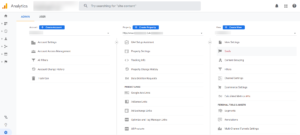Google Analytics installation is the first step to conversion tracking. You need conversion tracking to understand if your marketing is making money or wasting money. Without concrete data you’re left guessing and hoping that your online campaigns are working. And you know the old saying: Hope is not a strategy.
This post shows you how to install Google Analytics using Google Tag Manager and together these two products make conversion tracking much easier. We’ll cover installation of Tag Manager and Google Analytics (GA4).
Let’s get Google Tag Manager on your website and then install Google Analytics. Here’s how it works:
Identifying your Google Analytics Installation
There are currently two versions of Analytics available:
- Universal Analytics, which has been around for several years and will be deprecated in June 2023. Data currently in your UA account cannot be transferred to GA4. The databases are completely different.
- GA4, which is the replacement version and is available now.
Your Google Analytics situation will fit one of these scenarios:
- You have GA4 installed on your website. If so, skip down to the Google Tag Manager Section.
- You have the old version Google Analytics, but are unsure if you have GA4, or know you do not have it.
- You do not have a Google Analytics account.
You have the old version of Google Analytics but you’re unsure if you have GA4
Let’s check to see if you have a Google Analytics 4 property:
- Log into your Google Analytics account.
 In the bottom left corner, click the admin or ‘gear’ icon.
In the bottom left corner, click the admin or ‘gear’ icon.- A three-panel screen will open—Account, Property, and View. Look at the center panel, ‘Property’. You will see your Universal Analytics (older version) at the top. We know it’s Universal Analytics because the ID number is prefaced by ‘UA-‘. If you see a down arrow over to the right, it means you have multiple properties (which is a good sign for GA4).
- If you see a down arrow, click on it to
- You will see a list of all your properties. GA4 properties will have all numbers in the ID and are NOT prefaced by ‘UA-‘.
Create a GA4 Property on Your Existing Analytics Account
If you do not see a GA4 property, we can create one right now in just a few minutes:
- Click the blue ‘Create Property’ button. If that button is greyed out it means you do not have Administrator level access. You will need to ask the person who manages your Analytics account to upgrade your authorization.
- After clicking on ‘+ Create Property,’ follow the ‘Property setup prompts on the next screen: Property Name (use your website domain name); Set Time Zone and Currency, then click ‘Next’.
- The next screen asks for information about your business; check the appropriate boxes and click ‘Create’. You now have a Google Analytics GA4 property!
- You will be presented with the ‘Google Site Tag,’ which has some code to be installed on your website. To reduce the number of tags on your website, we will be installing your Analytics using Google Tag Manager. You can close out the code on your screen.
Leave this browser tab open, we will need it shortly.
Now go to the Google Tag Manager Section below.
I do not have a Google Analytics Account
If you do not have a Google Analytics account, you will need to create one. It’s easy, and only takes a moment.
- Go to https://analytics.google.com and follow the create account prompts. The system will automatically create a GA4 property for you.
- After clicking on ‘+ Create Property,’ follow the ‘Property setup’ prompts on the next screen: Property Name (use your website domain name), Set Time Zone and Currency, then click ‘Next’.
- The next screen asks for information about your business; check the appropriate boxes and click ‘Create’. You now have a Google Analytics GA4 property!
- You will be presented with the ‘Google Site Tag,’ which has some code to be installed on your website. To reduce the number of tags on your website, we will be installing your Analytics using Google Tag Manager. You can close out the code on your screen.
Leave this browser tab open, we will need it shortly.
Now go to the Google Tag Manager Section below.
Leave this browser tab open, we will need it shortly.
Now go to the Google Tag Manager Section below.
Create Google Tag Manager Account
You can skip this section if you already have a Google Tag Manager Account with a GA4 configuration tag.
Gmail account
In order to create a Google Tag Manager account, you must have either a free or paid Gmail account. If you don’t have a gmail address, create one before taking away further steps.
Create Account and Container
Installing Google Analytics begins with Installing Google Tag Manager.
Go to https://tagmanager.google.com and click the ‘create account’ link. On the ‘Add New Account’ page complete the form:
- ‘Account name’ should be your business name.

- Country; the country of your business.
- ‘Container Name’ should be your website address.
- Target platform should be ‘Web’.
- Click ‘Create.’
Read the terms, and if you agree, click through.
You have created your Google Tag Manager account!
Load Tag Manager on Your Website
The next step is to load Tag Manager on every page of your website.
Tag Manager presents you with a screen containing two sets of code. To a non-coder, this does not mean very much. But don’t worry, you don’t have to understand the code, you just have to copy and paste one in the <head> of each website page and post the other in the <body> of each website page.

For non techies like me, if you did not understand about the head tag and body tag, do not attempt to insert the code to your website. You could bring down your site.
There are easier ways:
- Ask your website developer to load the code.
- Use a website plugin. Most popular website platforms like WordPress, Shopify, etc. have created simple ways to install Google Tag Manager without being bothered with code. For WordPress websites,
- add a header / footer ‘injection’ plugin and paste the Google Tag Manager code.
Option 1 – Ask your website developer to install the code
This is the simplest option. It should take your website manager only a few minutes to install the code. In fact, it’s very rare for a developer to charge for such a simple task.
Here’s what you need to prepare for your developer
Web code can be finicky, and sometimes applications like MSWord and email applications change the code’s symbols when pasted to their application.
For this reason, DO NOT paste this code directly into these applications.
Instead, open a text program, such as Notepad, and paste the Tag Manager code in there. Save the file. These programs will preserve the integrity of the code. Include the installation instructions in your message to your developer.
Option 2—Install Tag Manager with a Plugin
If you are using a plugin, you likely won’t need that code. Instead, you will need your Google Tag Manager Container ID.
To find your Container ID, click on ‘Admin’ in the top navigation menu. On the upper right side of the screen, you will see an alpha numeric code that begins with ‘GTM-‘. Copy that ID.
Go into your website plugin and find the place to enter that code. If you use WordPress, download a Google Tag Manager Plugin, and activate it.
If you are using Shopify, go into the ‘Marketing’ area and you will find a place to insert the ID number.
Most website platforms have a place to load Google Tag Manager for you. If needed, use the platform’s support to find the spot.
Paste the Google Tag Manager ID in the designated place and save the work.
We are now ready to go inside Tag Manager and make a few tags.
WordPress websites: Installing Tag Manager with a ‘Header / Footer Plugin
The Tag Manager code instructions tell us to insert the code into the ‘head’ of each page. There are WordPress plugins that will do just that.
Here’s how to find and configure a header/footer plugin:
- Log into your WordPress website and click on ‘Plugins’ on the left menu and then click ‘Add New’. If you do not see Plugins listed in the left menu, this means you do not have administrative access to your website. Contact your web developer or whoever has administrative access and ask them to increase your user access to ‘Administrator’.
- Click ‘search,’ and in the search box write ‘Head / Footer injection.’ Download and activate a plugin you like. Here’s a tip: Try to find a plugin with a high number of ‘active installs,’ good ratings, and has been updated recently. All this information is visible in the plugin details.
- Install and activate the plugin.
- Find the plugin information, which in the left menu. Some plugins create a new menu item, others get added under Tools.
- In the plugin setup, there will be a spot to paste the code and then save.
Google Tag Manager is now installed on your website!
GA4 Configuration Tag
Now that Google Tag Manager is installed on your website, let’s connect it to your Google Analytics account. All we need to do is insert your Analytics Measurement ID into Tag Manager. Here’s how:
Return to Analytics to get your Measurement ID

- In your open Google Analytics browser tab (or a new browser tab), return to your Google Analytics account.
- In the bottom left panel, click ‘Admin’.
- On the right panel under ‘Property’ click the ‘Data Streams’ menu item.
- You will see your Analytics account. Click the arrow on the far right to open the ‘Web stream details’ screen.
- In the top right corner, you will see ‘MEASUREMENT ID’. We will need that ID to put Google Analytics on your website. Copy the ID to your clip board.
- Return to your Google Tag Manager tab and Click on the ‘Tags’ in the left side menu and then click ‘New’.
- Name the tag in the upper left: Google Analytics [paste your Google Analytics measurement ID].

- Click in the ‘Tag Configuration’ area, which opens a menu. Choose ‘Google Analytics: GA4 Configuration.’
- The next screen shows a box called ‘Measurement ID’. Paste your Google Analytics measurement ID there. Make sure the ‘Send a page view event when this configuration loads’ box is checked.
- Scroll down to ‘Triggering,’ and click in the white space there. Select the ‘All Pages’ Trigger.
- Click ‘Save’.
Make sure the tag words with a quick test
Before we can call this tag complete, we need to test it. Here’s how:
- Go to the ‘Tags’ screen.
- In the top right corner, you will see ‘Preview’ and ‘Submit’. Click ‘Preview.
- On the next screen, input your website URL, including the prefix ‘https://’ and then click ‘Connect’.
- Two browser tabs open; one titled ‘Tag Assistant [Connected]’, the other your website name. Go to the ‘Tag Assistant’ tab and click ‘Connect’. You should see ‘Tags Fired,’ and under that you should see the tag you just created. It will be the name of the tag.
- Close this tab and return to Tag Manager. Click ‘Submit’ in the upper right corner.
You have just loaded Google Analytics to your website!
If the tag did not fire, go back through these instructions.
Congratulations!
You have successfully installed Google Tag Manager and Google Analytics 4 on your website. Now you are ready for website tagging and tracking important conversions like form completions, phone call and email clicks and a whole lot more!



